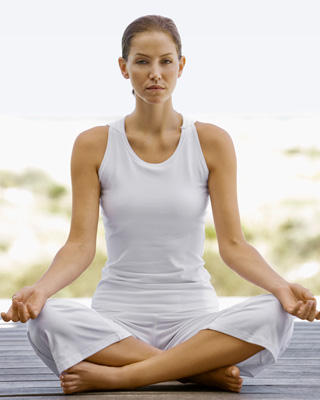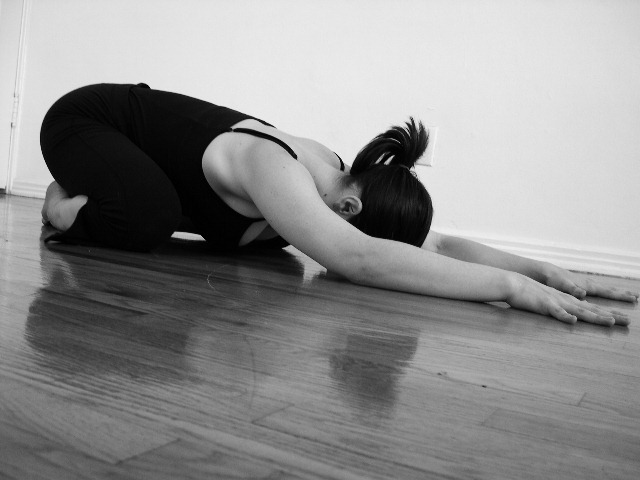 |
 |
|
 The
unification of body, mind did not get its start under the florescent
lights of a studio. Connecting the person with the cosmos, Yoga was
originally practiced outside, and with good reason – it is difficult to
truly connect with the vastness of the universe when you only practice
inside a studio? The
unification of body, mind did not get its start under the florescent
lights of a studio. Connecting the person with the cosmos, Yoga was
originally practiced outside, and with good reason – it is difficult to
truly connect with the vastness of the universe when you only practice
inside a studio?
There are
natural elements to connect to, but you cannot truly reach for the sky,
nor salute the sun while facing the 4 walls of your studio. But with
your feet on the Earth, the wind in your hair, and the sun shining on
you, it is easy to feel at one with the Universe.
There are many
ways to experience Yoga outdoors. An invigorating hike along a mountain
ridge can lead you to a breathtaking expansive view, where you can draw
the energy of your surroundings as you move through the mountain pose,
the tree pose, a downward-facing dog, sun salutations, or the warrior
poses. You might go for a solo weekend retreat, and practice by the
light of the moon, or go with a more adventurous route – such as white
water rafting retreats.
Whether you do Yoga in your backyard,
the park, the beach, the mountains, or next to a trickling prarie
stream, bring a humble sense of conscious awareness. As you open your
heart and mind, moving through various poses, the breathtaking beauty
of your chosen destination will truly start to reveal itself to you.
Inhale the rich aroma of nature – wherever you are. Hear the often
tuned-out sounds that are the Yogi’s most sacred music.
Yoga
makes most sense in the studio, for our daily learning, and Yogic
development. However, it is an unforgettable experience to bring your
wisdom to nature, and move through the many poses that were inspired by
nature herself. Take a deep breath, and reclaim your natural heritage.
|
|
 |
 |
|
Regardless
if you are recovering from the common cold, or from more serious
ailments, Yoga can help. Any yogic practice helps support the immune
system because it lowers stress levels, which has been repeatedly shown
to assist in immune function. However, there are more specific poses
that help support different functions of the body, and help ward off
certain ailments.
Overall:
Methodical, relaxing Yoga postures, with slow, controlled breathing
(pranayama) relaxes the body and allows the immune system its optimal
function. You can also support the thymus, the centerpiece for the
immune system, with the following poses: The Bridge, Cobra, The Fish,
the Boat, and The Tortoise.
 Upper Respiratory:
Downward-Facing Dog, and other inverted asanas promote more blood flow
to the head, and thus, the sinuses. The blood flow to that area will
help the sinuses to clear up more quickly – and will stave off
secondary infections by keeping the lungs and sinus cavities clear. Upper Respiratory:
Downward-Facing Dog, and other inverted asanas promote more blood flow
to the head, and thus, the sinuses. The blood flow to that area will
help the sinuses to clear up more quickly – and will stave off
secondary infections by keeping the lungs and sinus cavities clear.
Bronchitis/Smoker’s lungs:
Child’s Pose, Camel, Cobra, and Cow Face poses are all effective in
helping to clear the lungs, and prevent dangerous secondary infections
like pneuomonia.
Fever:
If you are sick with more serious ailments, like pneumonia or the flu,
your body needs rest above all. To help break the fever, and promote
your wellbeing, try the Easy Pose. This promotes proper breathing, and
relaxes the nervous system, without taxing the body. You can also try
the Corpse Pose, while laying in bed.
As with most things, an
ounce of prevention is worth a pound of cure. Take your health
seriously before you get sick, and promote your own wellness with
mindful yoga practice, proper nutrition, and good maintenance of the
digestive system, thus preventing a buildup of toxins in the body that
slow the immune system down.
|
|
 |
 |
|
Seldom
in the history of man is there a language that can carry power and
invoke emotion with each of its syllables. Sanskrit is one such
language. The original Sanskrit language stems back to the 2nd
millennium BCE, and is believed by some to be the oldest language in
the world, and the mother of all subsequent languages. Sanskrit is the
language that most Vedic studies were transmitted, including Yoga.
Originally
vedic, Sanskrit evolved to encompass a more complex language structure,
grammatical that laid out a formulaic approach to using the language in
both speech and composition -the first such known occasion of a formal
language structure. Even as other languages took shape, Sanskrit
continued to be the academic language – leaving a legacy of works in
its wake.
The use of Sanskrit brings us back to the origins of
the ancient practice of Yoga, with each utterance more of a prayer than
a word. The use of this ancient tongue in Yoga only furthers the
overarching aim of Yoga, which is present in the meaning of the
Sanskrit word Yoga: union.
Some other meanings:
Asana: Posture
Ha: The Sun
Tha: The Moon
Karma: Action
Praṇava: Shout, sound, or praise. The name of the Syllable “Aum”, or “Om”.
Namaste: The light within me honors the light within you
You
can incorporate this ancient and mystical language into your daily life
by studying the language, learning the Sanskrit names for various
poses, and meditating on the affect each word has on you. Incorporating
the language into the practice of Yoga will create a more unified
experience in your daily practice. Namaste.
|
|
 |
 |
|
 It’s
no secret that fear creates stress. The survival response that fear
invokes makes it difficult to complete other tasks and focus on larger
issues. In fact, according to renowned psychology theorist Abraham
Maslow, when our security is in jeapordy, whether our person, our
employment, our resources, or our family, we become anxious and tense,
and unable to focus on higher needs (like social relationships or
personal creativity). It could be a variety of things that concern or
worry us – things we feel fearful of. One person might cringe to
balance his checkbook, because he is afraid of the result. Fears can
make us do many unreasonable and illogical things. It’s
no secret that fear creates stress. The survival response that fear
invokes makes it difficult to complete other tasks and focus on larger
issues. In fact, according to renowned psychology theorist Abraham
Maslow, when our security is in jeapordy, whether our person, our
employment, our resources, or our family, we become anxious and tense,
and unable to focus on higher needs (like social relationships or
personal creativity). It could be a variety of things that concern or
worry us – things we feel fearful of. One person might cringe to
balance his checkbook, because he is afraid of the result. Fears can
make us do many unreasonable and illogical things.
We cannot
simpy eradicate fears, for fear is often a healthy response to our
surroundings, or situations requiring quick action. But long term
worries are milder, chronic fears as well; we just know them by a
different name. We may not be able to eliminate fears and worries, but
we can reduce their impact by learning how to decrease our tension and
control feelings of anxiety.
Yoga sessions are wonderful for
reducing stress and anxiety, and the daily practice of Yoga can be
called upon in our times of more intense fears. Yoga promotes the
soothing of the nervous system by teaching us how to connect to our
thoughts and the effect they have on our bodies. Deep, relaxed
breathing penetrates our worries and resonates through our nervous
system.
While dropping into downward dog would not be
appropriate if you were confronted by a mugger, your Yoga class will
help you to combat your fear, and regain the levelheaded control that
you need to navigate your situation. Implement deep breathing, and draw
from the energy of your practice. You will find yourself more in
control, and ready to face anything.
|
|
 |
|
|
|
 |
|
In This Issue
|
|
 |
|
Updates from the studio
|
|
Name

Phone
My Website
|

|
|
Mandala meditation
|
Mandalas
are great meditation tools, as it gives our mind something to focus on,
while subjugating outer thoughts to the representation of the Mandala.
To meditate on a Mandala:
1. Find a Mandala that represents what you want to focus on.
2. Focus on the center of the Mandala while you relax.
3. Breathe slowly.
4. Blink as little as possible.
Mandala
will appear to shift, and the colors will brighten or fade. Be
receptive to what you see and allow the energy to flow through you.
|

|
|
Yoga for Insomnia
|
|
There
are a host of reasons why insomnia is on the rise. Daily anxieties and
stress, feeling overwhelmed, depression and hypertension are all
possible causes for insomnia. When you find yourself unable to rest,
try some light nighttime yoga:
1. Start in Cobbler’s Pose,
sitting upright, let your legs drop open, with the soles of your feet
firmly pressed together, hands behind you. Sit in this pose for a few
minutes.
2. Lean back, bringing your elbows to the floor, and
continue until your back is on the floor (or on pillows or cushions, if
you are uncomfortable leaning back to the floor). This is the Goddess
Pose. Stay here for a few minutes. Roll to the side to release this
pose.
3. Move to the corpse pose. Lay flat on your back, letting
your feet flop out to the sides. Rest your arms next to your body and
face the palms upwards. Relax your body and breathe naturally. Stay
mentally focused.

|

|
|
Yoga Clothes
|
|

Yoga doesn’t need to be a fashion show, but there are some
quick guidelines for the best types of clothing to practice in:
-Free range of motion and comfort are essential.
-Avoid jeans, ill-fitting items, or baggy shirts. Try leggings, shorts, or yoga
pants. Some opt for unitards to promote the full freedom of movement.
-If you do not want to perform yoga with bare
feet, you can opt for a pair of yoga socks, which will prevent slipping.
Special shoes are also available.
-Before you wear an outfit to Yoga, you should
test a few poses in the outfit, to see how it works.
|
|
 |
